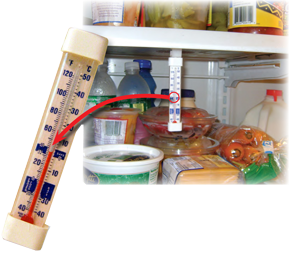 1. A digital thermometer. A tip-sensitive digital thermometer will make checking the internal temperature of meat, soups, and casseroles accurate and easy. These days, food thermometers aren’t just for your holiday roasts—they’re for all cuts and sizes of meat, poultry, and fish, including hamburgers, chicken breasts, and pork chops. Use them for soups and casseroles too. Using a food thermometer when cooking meat, poultry, fish, soups, and even egg dishes is the only reliable way to make sure you are preparing a safe and delicious meal for your family. As an added bonus, not only do thermometers help with food safety, they also keep you from over-cooking food! No more worrying if something is done; check with a thermometer and you will know for sure. The USDA has information about thermometer placement for accurate readings available in both English and Spanish. There are easy-to-remember temperatures where you know your food is safe to eat.
1. A digital thermometer. A tip-sensitive digital thermometer will make checking the internal temperature of meat, soups, and casseroles accurate and easy. These days, food thermometers aren’t just for your holiday roasts—they’re for all cuts and sizes of meat, poultry, and fish, including hamburgers, chicken breasts, and pork chops. Use them for soups and casseroles too. Using a food thermometer when cooking meat, poultry, fish, soups, and even egg dishes is the only reliable way to make sure you are preparing a safe and delicious meal for your family. As an added bonus, not only do thermometers help with food safety, they also keep you from over-cooking food! No more worrying if something is done; check with a thermometer and you will know for sure. The USDA has information about thermometer placement for accurate readings available in both English and Spanish. There are easy-to-remember temperatures where you know your food is safe to eat.
2. A refrigerator thermometer. A refrigerator thermometer will help you know that you are storing food at the right temperature and will help limit spoilage from a too-warm  refrigerator. Your refrigerator should be set between 32 and 40 degrees F. A standard refrigerator temperature is 34 degrees F. Keeping your refrigerator at the correct temperature will help to prevent spoilage and ensure safety too. Putting a thermometer in your freezer is also a great idea. A standard refrigerator-freezer will run at -10 degrees F; a dedicated chest freezer should run at -20 degrees F.
refrigerator. Your refrigerator should be set between 32 and 40 degrees F. A standard refrigerator temperature is 34 degrees F. Keeping your refrigerator at the correct temperature will help to prevent spoilage and ensure safety too. Putting a thermometer in your freezer is also a great idea. A standard refrigerator-freezer will run at -10 degrees F; a dedicated chest freezer should run at -20 degrees F.
3. A good supply of cutting boards. There are many types of cutting boards: plastic, wood, glass, and other materials. Each has its own advantages and disadvantages. The important thing about cutting boards is to choose ones that are easy to keep clean and dry (to prevent microbes from contaminating the board). Also, replace cutting boards when they become scarred with knife marks which can provide a place for microbes to hide. It’s a great idea to have separate cutting boards for raw meats and other cutting boards for foods that are ready-to-eat, like cooked meat, fruits, and vegetables.
Additional information on these three kitchen items are in an article from NutritionAction.com. Stay food-safe!




